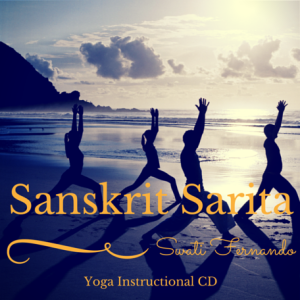The Sanskrit names of poses are easier to understand when you know a few words. Here is a short song to be sung to the tune of Head and shoulders, knees and toes.
Most of the poses have some loose connection to the English verses. The English spelling of the sanskrit words are not always standard and not all the nuances of pronunciation are conveyed. For instance, a word pronounced “shavasana” is often spelled as “savasana”. Vowel sounds can also be a guessing game. If you are interested in how these are to be pronounced, then I have just the thing for you, Swati’s Sanskrit Sarita CD, a pronunciation guide for the sanskrit names of yoga poses as well as other Sanskrit yoga vocabulary.
The song…
Headstand, shoulder stand, head to knee pose, extended hand to big toe pose, reclining hand to big toe pose. (repeat 2x)
Three-limb face over one foot west side of the body stretch (forward fold)
Sirsasana, Sarvangasana, Janu sirsana, Utthita hasta pandangustasana, Supta pandangustasana (repeat 2 x)
Trianga mukhaikapada paschimottanasana
Okay, so it’s not my best work, and the last line, which is just one pose, doesn’t translate well into English. If you learn that one, you will appear to know what you are talking about if you can get that one to roll off the tongue. Although I have read other explanations of what the three limbs (trianga) refer to, it makes sense to me that it’s a forward fold, paschimottanasana, with one leg folded back, hence the three limbs are the two arms and one leg. You have your face (mukha) coming over your one leg or foot (ekapada)
Some body parts and poses named after body parts
headstand = sirsasana (sheershasana)
shoulderstand = Sarvangasana
knee = Janu
head = sirsa
foot = pada
hand = hasta
Big toe = angusta
face = mukha
Extended hand to big toe pose – Utthita hasta pandangustasana
Supine hand to big toe pose = supta padangustasana
Some words used in names of poses
asana = pose
supta = supine, lying on the back
utthita = extended
eka = one
dwi = two
tri = three
chatura = four
anga = limb
paschima = west side, the back of the body is considered the west side.
svan = dog
adho = down, as in adho mukha svanasana
urdva = up, as in urdva mukha svanasana
ut = intense
tan = stretch
ardha = half
chandra = moon
virabadra = warrior, as in virabadrasana 1
vira = hero
kona = angle, as in trikonasana
baddha = bound
parsva = side, as in utthita parsvakonasana
parivrtta = revolved, as in parivrtta trikonasana
Sanskrit Sarita CD
Last year, I worked on a small project for my friend and Sanskrit instructor, Swati Fernando. She needed more copies made of a sanskrit pronunciation CD that she recorded a few years ago. I did a little regroovenating to make the CD easier to use. It used to be one continuous track, about 45 minutes long. What I did was divide the recording into separate tracks and listed all the words that are included on the CD. If you would like to buy a copy, contact Swati by email. (swati DOT fernando AT gmail DOT com). She also teaches amazing vegetarian Indian cooking!

This is excellent June!!
I can see you have put a ton of work into this.
Thank you!!
Hurrah hurrah! Love this helpful little post with stick figures a plenty!